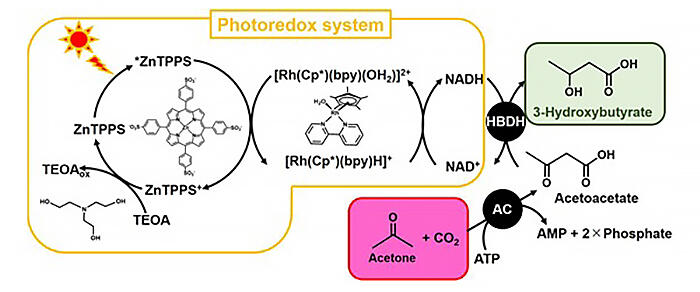A research team led by Professor Yutaka Amao from the Research Center for Artificial Photosynthesis, and graduate student Yu Kita from the Graduate School of Science, Osaka Metropolitan University, has successfully synthesized 3-hydroxybutyrate, a robust and water-insoluble polyester used as a raw material for Poly-3-hydroxybutyrate (PHB: commonly used in packaging materials) using acetone (an organic compound widely used as an organic solvent) combined with carbon dioxide, a photoredox system, and two enzymes. The method has a high yield of about 80%. The team looked to natural photosynthesis, which uses solar energy to fix carbon dioxide into glucose and starch. It believed that an ultimate form of artificial photosynthesis could be produced if it could fix carbon dioxide in organic compounds as a raw material, producing materials for biodegradable plastic and actual plastic. To achieve this, the team expressed two enzymes, acetone carboxylase (AC) and 3-hydroxybutyrate dehydrogenase (HBDH), in photosynthetic bacteria. These enzymes were extracted and added to a photoredox system consisting of a dye and catalyst. As a result, carbon dioxide and acetone combined to produce acetoacetic acid through the AC, and acetoacetic acid was converted to 3-hydroxybutyrate through the HBDH. The yield rate from acetone is relatively high, about 80%. This finding indicates that 3-hydroxybutyrate can be efficiently synthesized using this new artificial photosynthesis-based technology.

Provided by OMU
Professor Amao said, "Most artificial photosynthesis research aims to generate next-generation fuels, such as by splitting water to produce hydrogen and reducing carbon dioxide to produce carbon monoxide, formic acid, and methanol. I decided to re-examine natural photosynthesis, which produces starch, a polymer, from carbon dioxide, to achieve a form of artificial photosynthesis that creates useful biodegradable plastics from carbon dioxide."
This article has been translated by JST with permission from The Science News Ltd.(https://sci-news.co.jp/). Unauthorized reproduction of the article and photographs is prohibited.




